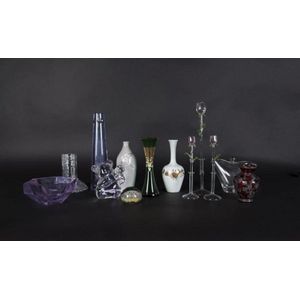
Glass and Porcelain Collection
Murano glass paperweight, Orrefors glass koala, vase and candlestand, Italian glass vases, Swarovski Crystal flowers, Danish porcelain vase and Bjorn Wiinblad vase (13 pieces), tallest 29 cm
Swarovski is an Austrian company founded in 1895 by Daniel Swarovski. The company is known for producing high-quality crystal jewelry, figurines, accessories, and lighting products.
Daniel Swarovski was born in 1862 in the Bohemian region of Austria-Hungary. He learned the art of glass cutting and polishing from his father and later attended a school for mechanical engineering in Vienna. In 1892, Swarovski patented an electric cutting machine that revolutionized the production of crystal glass. He later founded his own company in Wattens, Austria, in 1895, which specialized in the manufacturing of crystal glass.
Swarovski crystals became popular for more...
Paperweights, used to hold down papers, and most commonly made in glass, evolved in Venice in the early nineteenth century, and spread to France via Bohemia about 1845, where the finest examples were produced by three factories: Baccarat, Clichy and St Louis. Examples from these manufacturers are mostly unmarked and widely faked and imitated and thus a minefield for the uninitiated. The most popular motif is millefiori ('thousand flowers'), though fruit, single flowers, insects, and other small objects are often used as well as portraits and view. The cheaper paperweights use air bubbles as decoration. The classic paperweights are round more...
4 items found:
These items have been sold, and the description, image and price are for reference purposes only.

Murano glass paperweight, Orrefors glass koala, vase and candlestand, Italian glass vases, Swarovski Crystal flowers, Danish porcelain vase and Bjorn Wiinblad vase (13 pieces), tallest 29 cm
 Loading more...
Loading more...